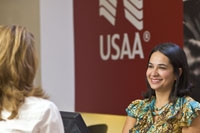FEATURE1 August 2011
All MRS websites use cookies to help us improve our services. Any data collected is anonymised. If you continue using this site without accepting cookies you may experience some performance issues. Read about our cookies here.
FEATURE1 August 2011
The top performers in Nunwood’s US customer experience rankings have one thing in common – deep understanding of their customers, says David Conway.
Delivering excellent customer experience requires an unswerving dedication to really understanding the customer. In these rapidly changing and fickle times, what satisfies today might frustrate tomorrow, so continuously keeping abreast of needs is vital for success.
Nunwood recently published a league table of US companies based on customer experience, following on from a similar piece of work in the UK last year.
Our analysis shows that there are a number of new techniques that the top performers have embraced to understand their customers better than their competitors.

USAA, the financial services provider for current and former US military personnel and their families, was the stand-out leader in our survey, with the sophistication of its approach to social media being a major differentiator. In 2009 USAA laid out its social media strategy, listening and reacting to what its members are saying about its products and services online and promptly resolving service issues.
This approach goes as far as joining in online conversations to answer members’ questions and queries and using social tools and practices to understand its members better than anyone else.
Offline, USAA is focused on integrating the traditional methods of customer research with the vast quantities of information available from new media. An extensive voice-of-the-customer programme systematically monitors the quality of service delivery through telephone and the web, so the USAA team can see where customers and potential customers begin the acquisition and servicing process, and where they drop off. The team uses technology to analyse millions of log entries and page views each day. Customer satisfaction levels are consistently above 90 per cent.

Amazon’s dedication to understanding customer needs is well known. The recommendation engine, which processes huge quantities of customer insight every day, is valued by customers, making them feel that they are getting a personalised experience.
Founder Jeff Bezos describes the best service as no service, when things just work. Amazon assiduously measures the number of customer queries per transaction. Using vast quantities of customer feedback, it focuses on identifying the root causes of queries and removing them.
In common with many excellent organisations, all Amazon employees spend at least two days a month working with customers on the front line, experiencing customers’ issues first hand and using that understanding to improve its service. When it comes to research, Amazon believes the best way to get their employees to understand the customer is to get them to share customer experiences.

Red Lobster, the nationwide seafood restaurant chain, has annual sales of $663m and 700 locations. Its value proposition resonates perfectly with its customers and research is crucial. In 2008, the chain installed wood-fired grills in all of its restaurants.
The company conducted focus groups and studied seventeen different cooking platforms before undergoing this change. They decided on wood grills for their ability to impart flavour and because of their widespread availability.
Research was instrumental in creating the Red Lobster experience of today. In 2003 the restaurant chain suffered from a drab image and declining customer satisfaction. Marketer Kim Lodrup was promoted to president with a mission to turn things round. He turned to intensive customer research: “We find out what guests want from an idealised dining service and research how to deliver value to guests.”
Red Lobster follows changing customer habits and notes the dishes customers prefer. It uses phone and online surveys to learn about guest attitudes towards the food they have tried and determine how they might react to new menu items or concept changes before instituting them.
After research studies indicated that freshness is the single biggest factor consumers use to judge a seafood restaurant, the chain set about communicating that fresh fish is delivered to all of its locations on a daily basis.

In an industry characterised by mistrust, financial services broker Charles Schwab is in a different league. Its customers not only trust it, they are delighted by the service they receive.
With an insight and loyalty department of more than 70 people, customer knowledge is a vital component of its success.
Ethnography, qualitative and quantitative techniques are used to develop a deep understanding of the customer. Spending time in investor homes to reveal insights and understanding gave rise to the recent, hugely successful Talk to Chuck campaign. The research revealed serious pain points for investors, Charles Schwab had solutions, the advertising communicated them and, even in these difficult times, customers turned to Schwab in their droves.

Olive Garden, the Italian restaurant chain, is the sister company of Red Lobster, and both businesses attribute not just their success, but their existence, to research.
Owned by Darden, its 22-strong insight team invite 16m customers a year to rate their satisfaction. “In restaurants, consumers are always shopping the competition, which reinforces the need to monitor how you are doing,” says head of insight JJ Buettgen. “We sample guests every day. We want to know how their last meal was.”
Founded in 1982, the chain grew rapidly, but by 2000 it had lost its way. Darden turned to research. The key insight was that people missed the emotional comfort and connectivity that comes with family. Drew Marsden, then the company’s head of marketing, said: “People come to a restaurant for both physical and emotional nourishment. The physical is the food, the emotional how you feel when you leave.”
Thus the Olive Garden brand has been rebuilt around the notion that guests are treated like family, but employees are treated like family too. David Pickens, president of Olive Garden, says: “Employees need to believe that serving meals, cleaning tables and cooking in hot kitchens is meaningful. It is very difficult for the experience of the guest to exceed the experience of the staff – we put the two together.”
0 Comments